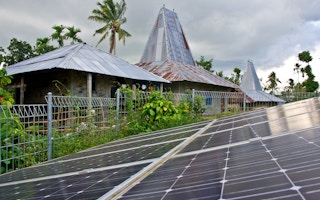In recent months, a rising number of countries have pledged to reduce greenhouse gas emissions to net zero. Globally, 124 nations have made net-zero pledges leading up to this year’s world climate summit in Glasgow (COP26). Despite varying deadlines, the recent net-zero movement has provided an “opening” to spur the decarbonisation of the global economy.
The wave of countries committing to carbon neutrality has also arrived in Southeast Asia, home to some of the fastest-growing economies in the Asia Pacific region. Singapore was the first in the region that jumped on the net-zero carbon bandwagon with its pledge to achieve carbon neutrality in the second half of the century, enshrined in the “Singapore Green Plan 2030”. Earlier this year, the Ministry of Environment and Forestry of Indonesia’s Ministry of Environment and Forestry expressed its hope to achieve net-zero emissions by 2070. Prompted by the recent Leaders’ Summit on Climate convened by United States President Joe Biden, Malaysia and Thailand have also started dialogues around setting similar targets.
The key to achieving net-zero emissions is a global energy transformation, shifting from a fossil fuel-based and energy-intensive society to one that is renewables-based and energy-efficient. For this, we need public support. And therefore, we need an energy transition that citizens can be part of and that benefits everyone. That’s because grassroots participation has been shown to increase overall support for renewable energy projects, which will ultimately speed up the transition.
In Europe, there are myriad inspiring success stories of local authorities and communities coming together to create renewable energy solutions. This can be in the form of rooftop solar panels in schools, community-owned hydroelectric installations, or wood-fired biomass plants. This high level of citizen involvement is also needed in Southeast Asia. The region’s efforts in keeping up with the increasing energy demand whilst achieving the regional target of 23 per cent renewable energy in the primary energy mix by 2025 should not overlook the potential community involvement could yield.
While current renewable energy and energy efficiency policies introduced by the member states of the Association of Southeast Asian Nations are already considered insufficient to achieve the regional clean energy targets, the Covid-19 pandemic has slowed down green energy deployment further. Putting the region back on track will require bigger and more innovative changes. Therefore, citizen involvement is now more important than ever.
How to build active participation
The question is, how could citizens lead the energy transition?
Citizen engagement begins by raising energy and climate literacy and awareness among communities through local events, campaigns, and dialogues. Although this stage only enables the lowest degree of involvement, it is fundamental to improve communities’ knowledge of energy policies, technologies, best practices, and new ideas. Well-informed citizens can shift communities’ perceptions and ultimately increase the levels of acceptance of renewable energy. Low acceptance has been shown to hamper clean energy deployment, as indicated by the increasing clashes between energy project developers and local communities.
Through awareness-raising efforts, citizens could be turned into advocates for renewables and may pressure decision-makers to speed up the energy transition. At the highest engagement level, citizens could take ownership of local renewable energy and energy efficiency initiatives, which could further influence low carbon transformation governance.
Moreover, citizens could steer the local green energy agenda by becoming active “prosumers” instead of mere consumers. Being a “prosumer” involves generating clean power—usually using solar panels—for your own use and feeding excess electricity to the grid to earn income.
Trends of active citizen participation in Southeast Asia
Although not directly climate-driven, a recent electricity bill surge amid the Covid-19 pandemic in the Philippines has seen a rise in citizen participation. Motivated to reduce electricity bills, many Filipinos have joined the prosumer movement by installing solar panels on their roofs. To enable Filipinos, including low-income households, to become prosumers, many local organisations had lobbied the energy regulators to facilitate communities’ growing aspirations. Such advocacy has borne fruit: Recent policy amendments by the Energy Regulatory Commission include the launch of a net-metering programme, attractive incentives, and other support.
In Indonesia, a local non-profit, IBEKA, urged the government to allow the national grid operator to buy electricity from independent small-scale hydropower plants that the organisation had been pushing for over the last decade. And these efforts, too, have been successful. A newly amended law has been passed to accommodate community-led renewable energy projects in the national grid. IBEKA has built 70 small and micro-hydropower plants, supplying electricity to half a million people in rural and remote Indonesia.
These two examples are only the beginning of community-led green energy initiatives in Southeast Asia, but they show that citizens already have an impact on energy policy. Yet for every success story, many more endeavours fail due to policy barriers and other challenges.
Closing policy gaps
The main obstacles to citizen engagement boil down to the centralised design and regulation of current energy systems, which do not provide a level playing field for community-led energy initiatives. Besides, citizen participation can be inhibited by financial barriers. Other challenges include lack of awareness, information and empowerment on citizens’ part, as revealed by a recent study conducted by the World Energy Council.
Those barriers need to be addressed for citizen participation to gain traction, starting with a framework reformation. The United Kingdom’s Community Energy Strategy provides a good example of measures to support the growth of community-led green projects through various incentives, including feed-in-tariffs and quotas for local ownership of renewable energy projects.
Another example is Denmark’s energy policy, which grants permits to renewable energy projects only if at least 20 per cent is owned by local communities. Further, innovative green financing should be encouraged as exhibited by citizen-funded solar projects in Japan of which within one year, 460 people had invested, reaching about US$3.3 million that was enough to cover 55 per cent of the total project costs to install solar panels at 38 facilities including schools and community centres.
Capacity building and knowledge sharing programmes should also be on the agenda in Southeast Asia. Also, there is a need to foster a close relationship between citizens and the government. Digital platforms could be a practical option to connect stakeholders.
Some Southeast Asian nations have displayed leadership in bottom-up renewable energy development. Now it is time for others to follow suit and create an environment conducive to community-led clean energy deployment to put the region on a path to a net-zero future.
Monika Merdekawati is a technical officer of the renewable energy and energy efficiency department at the Asean Centre for Energy. Natasha Agustin Ikhsan is an intern of the renewable energy and energy efficiency department at the Asean Centre for Energy.












